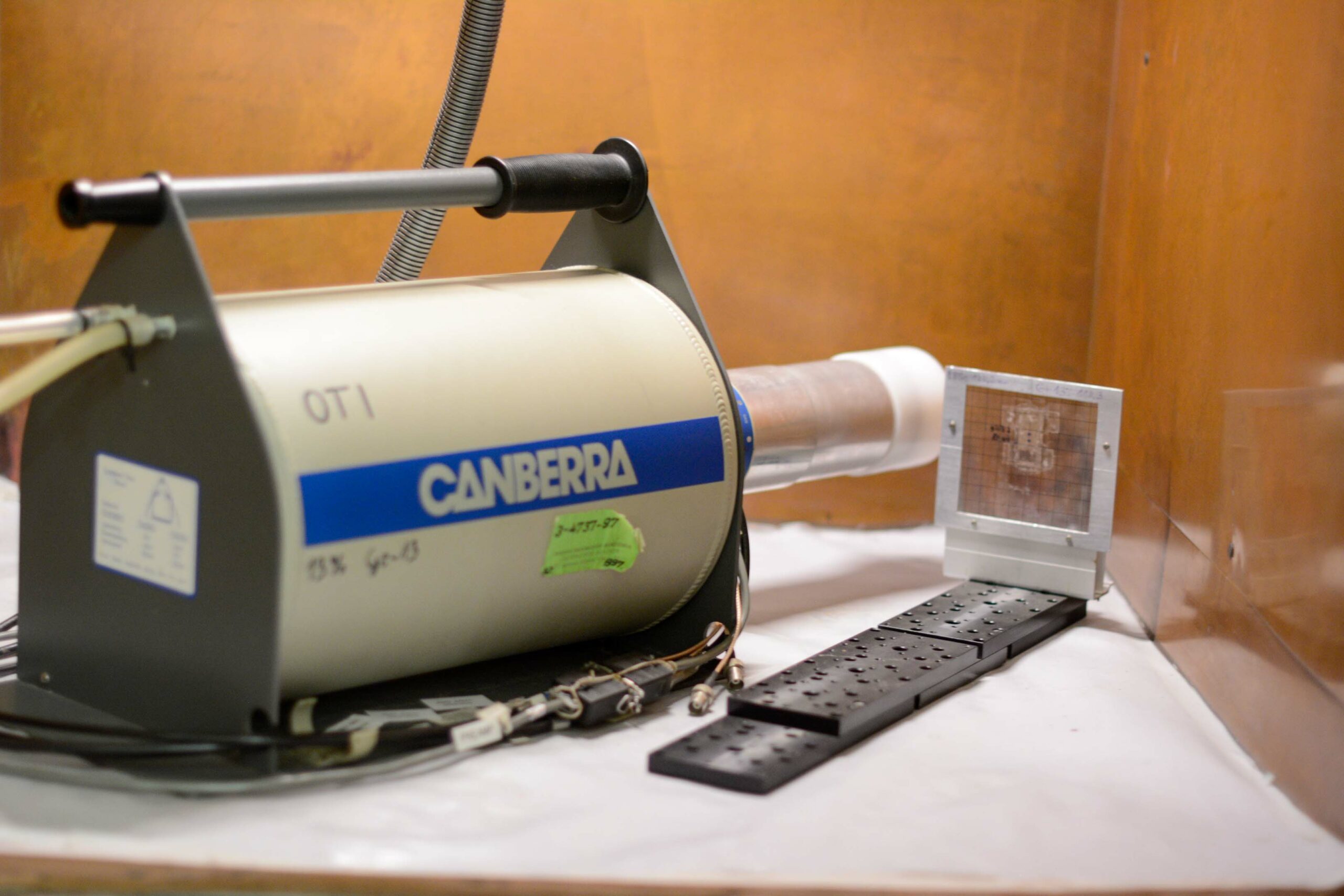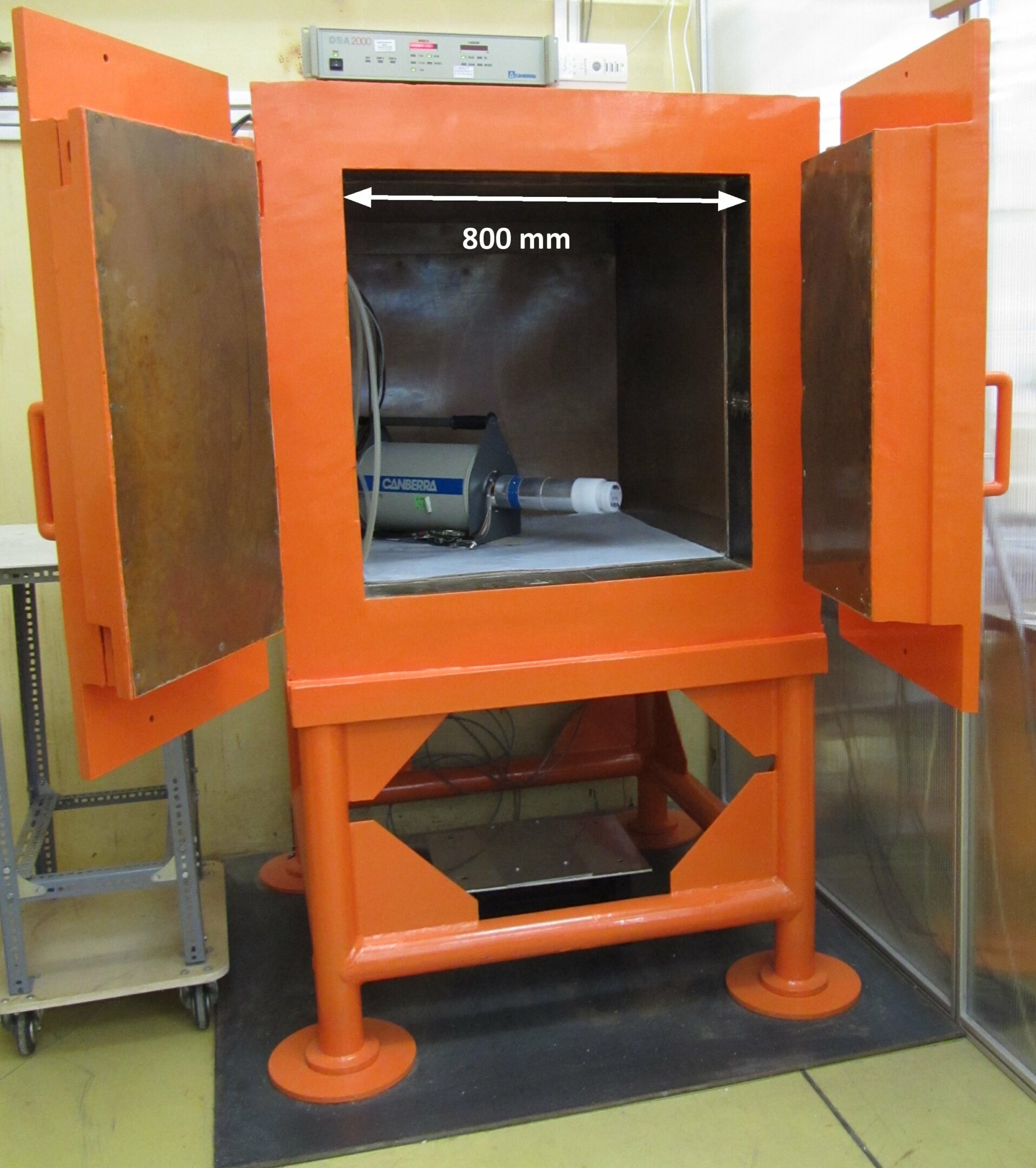- Name: DÖME Low-Level Gamma-Spectroscopy Facility
- Technique: gamma spectrometry in low-background counting chamber
- Range of investigated features: activity of different radioisotopes
- Typical size of sample: from less than 1 g to more than 10 g (depending on the activity)
- Measurable materials: no restrictions, can be – properly packaged- solid, liquid and gaseous
- Contact: dome@bnc.hu
- Poster of the instrument

DÖME instrument is a facility suitable for measuring decay gamma spectra. Its main part is a low-background counting chamber made of pre-World War II iron, thus free of radioactivity from human activities. A liquid nitrogen cooled HPGe detector placed inside the chamber acquires the gamma spectra. Having adjusted the sample-detector distance within wide limits, the setup is suitable for measuring samples both with lower and higher activity. This instrument is well suited for measuring the decay gamma spectra of samples activated during PGAA measurement. The samples can very quickly be transferred from the PGAA or NIPS instruments to the DÖME, even in a minute or two, so that radioisotopes with a short half-life of even a few minutes can be measured. The DÖME instrument is a good complement to the PGAA and NIPS station for measuring elements that can typically be measured with lower detection limits and with less uncertainty from the decay spectra than from the prompt ones (e.g. Au, Na, Ga, W, etc.). In addition, due to the low background level in the sample chamber, this instrument can also be used to measure the radioactivity of various environmental samples, such as soil and rock samples. For the measurement of environmental samples, radon-gastight sample holders made of high-density polyethylene are available.
The DÖME (DÖgnehéz Mérő Eszköz or “damn heavy measuring tool”) low-level counting station is found in the cold-neutron guide hall of Budapest Neutron Centre. The purpose of DÖME is to assist the in-beam neutron activation measurements with off-line counting option on a routine basis and to allow the measurement of environmental samples of low activities. The facility’s main features are instant and local availability in the cold-neutron guide hall and highly accurate activity measurement.
The low-level counting station consists of an iron chamber manufactured from pre-World War II iron (recycled material of the bombed Elisabeth-bridge, 1945), and is, therefore, free of any man-made radioactivity. The wall of the chamber is 155 mm thick and has a graded shielding (148.5 mm Fe, 5 mm Pb, and 1.5 mm Cu layers). The chamber with an internal dimension of 800×800×800 mm3 accommodates a Canberra GR1319 HPGe detector of 13% relative efficiency with a BigMAC cryostat along its horizontal diagonal. This geometry allows sample-to-detector distances up to 250 mm.
As an option for targeted measurements of low-energy lines, a Canberra Low Energy HPGe (GL1018) detector is also available with better energy resolution but for a narrower energy range (up to about 1 MeV). A Canberra DSA-2000 digital gamma spectrometer with 16k channels is used for the data acquisition. With the GR1319 detector, the facility has a spectral background of about 1.39 cps over the energy range of 7-3150 keV, which compares to 211 cps outside the chamber (i.e. a reduction factor of 152). Dead-time losses during the experiments are typically below 1%.
In-beam-activated powder samples can directly be measured in the Teflon bag typically used for the PGAA or NIPS-NORMA experiment. Solid samples can be analysed as received. For powdered environmental samples an easily re-sealable, radon-gastight sample holder from high-density polyethylene is available.
The three main parameters of the facility are detection efficiency, channel-to-energy calibration with nonlinearity, and energy resolution. These are established using commercially available certified radioactive sources (152Eu, 207Bi, 60Co, 133Ba, 241Am and 226Ra). The system can be calibrated for different sample geometries and different sample detector distances from the contact geometry up to approximately 240 mm. The Nonlinearity and Resolution analyses modules of the HyperLab software are used to determine the nonlinearity and resolution of the detector. The efficiency for the given sample detector distance and point source sample is determined with the HyperLab Efficiency analyses module. The Excel-based efficiency transfer program Efftran and its macros are applied to determine the detection efficiency of larger samples (that cannot be considered as a point source), or of samples measured close to the detector (in this case true coincidence effects could have a significant influence).

Figure 1. The photo of the low-background counting chamber weighing 8t

Figure 2. Sample holder for in-beam activated samples with a well-reproducible sample detector distance

Figure 3. Radon-gastight sample holder for environmental samples

Figure 4. The absolute full-energy peak efficiency for point sources at 167 mm in the DÖME counting station

Figure 5. Nonlinearity of DÖME counting station

Figure 6. Energy resolution of DÖME counting station
Article about the instrument in more detail:
Z Kis, P Völgyesi, Z Szabó. (2013) DÖME: Revitalizing a low-background counting chamber and developing a radon-tight sample holder for gamma-ray spectroscopy measurements. J Radioanal Nucl Chem. 298(3) 2029-35. DOI: 10.1007/s10967-013-2691-8